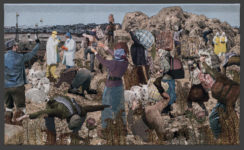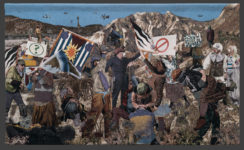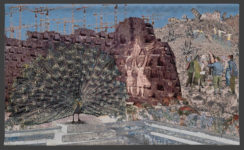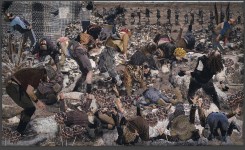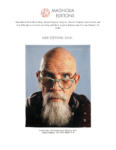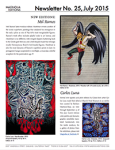The following interview with Brooklyn, NY-based artist duo Anthony Aziz and Sammy Cucher was conducted at Magnolia Editions in Oakland, CA on July 27, 2016. Having spent a week at the studio working on a suite of tapestries commissioned for an art space in Hong Kong, Aziz + Cucher spoke to Nick Stone about the influence of tapestry on their work in other media; using the southern California landscape as a stand-in for the Biblical desert; and their tapestries’ unintended thematic relevance to the American presidential election, which was at the time still many months ahead.
NS: The imagery in your first tapestry Some People comes from a performance of the same name which included a cast of dancers who you choreographed into specific movements. Could you tell me a little bit about the particular image used in the tapestry and how the various elements came together?
A+C: We were really taken with the idea of creating a tapestry that was an extension of all the video work we did, but in the style of a Renaissance tapestry that deals with narrative or an event — in this case, a current event. We're interested in the politics of tapestries traditionally and historically, and how we might tap into that in a more contemporary way. Even though it's not a specific event, we wanted to compositionally refer to the tradition of tapestry making in the 16th century. So that's why you see a dense number of figures packed together in a space that tries to evoke that tradition.
NS: You want to refer specifically to tapestries of that period, and the role they played…?
A+C: They played the role of propaganda between kingdoms and tribes, nation-states and city-states —
NS: In the service of power.
A+C: In the service of power, to proclaim power — not only through the iconography, but through their cost, because they were so expensive to make. To be able just to display them, let alone to commission a whole cycle; King Henry VIII, for example, was a great collector of tapestries, and he would commission series after series after series at great, great expense.
NS: So the medium is the message; it automatically conveys wealth and power.
A+C: Also they're commemorating historical conquests and battles… So yes, we're interested in tapping into that tradition of historical arrogance in tapestries.
NS: So to be even more specific, the tradition of tapestries depicting conflict.
A+C: Yes. But to go back a little bit into the question in terms of the provenance of the imagery, it comes from the video piece Some People that we did for the IMA show. It's an eight channel video piece displayed on a 270-degree visual field, and the figures come and go through that field at different points in time. It's a 13-minute loop, so events and gestures and poses occur during this period of time. I think what the tapestry did was to collapse the whole piece into a single frame.
In fact, when we were making the video, we were thinking about it in terms of making an animated tapestry. In our imagination, it was as if we were making a tapestry. Originally, it had to do more with the flatness of space that occurs in tapestries. Because our video is also not a traditional video; the figures are recorded separately from the landscape with a green screen and then composited together, and this composition flattens things. We were also using this very vast desert landscape. It's like you're looking through a telephoto lens, so the landscape and the figure appear flattened together.
NS: Were there any specific tapestries or cycles, like the Unicorn Tapestries, that you had in mind or was it a more general inspiration?
A+C: I don't think there were any specific ones but our whole fascination and desire to work with tapestry began with the "Tapestry in the Renaissance" exhibition at the Metropolitan Museum in 2002. That was an encyclopedic exhibition; they managed to pull together tapestries from all the museums and courts in Europe and bring them to New York. I don't know if there was one specific work we were referring to but there are elements that probably came from that show. The use of gesture, the use of pose, the placement of figures in relation to one another to evoke storylines were useful in approaching what we do — which doesn't tell an easy story; it opens up the possibility for interpretation but doesn't answer any particular questions.
NS: What is the landscape that you placed the figures in?
A+C: The video landscapes were shot in Israel and in southern California, because we spend a lot of time in Joshua Tree and we really think of Joshua Tree as a Hollywood stand-in for the Biblical landscape. Similarly, for the tapestry we took photographs that we'd taken in both locations, Israel and southern California, and composited them.
NS: So you have the actual Biblical landscape and the Hollywood Biblical landscape combined into one…
A+C: Cut up together, merged. You have to remember in Renaissance painting and also Renaissance tapestry, when they illustrated the stories of the Bible, which was a very common theme, they also had an invented Biblical landscape because most of those painters had never been to the land of the Bible; probably none of them. So they had this idea of Jerusalem, this idea of the desert of Moses — and it probably looks more like some kind of rock in the Netherlands than the actual thing.
NS: Just like the American West — it becomes kind of fictionalized.
A+C: Exactly. It's the same idea: you have to use the landscape that's around you to create the landscape that's in your mind.
NS: Outside of a gallery setting, where do you see your tapestry hanging?
A+C: Besides museums, we've talked about tents as another way to contextualize them. Because during the Renaissance period, the sites where battles were fought and won were also the places where negotiations would then occur. The rulers of the warring states would come together and set up their tents, and they'd bring their tapestries with them. Again, it was an opportunity for them to show their power. They were also meant to keep the tent warm.
NS: It's a way of erecting a temporary castle.
A+C: Yes; so we would consider doing that, if such an installation opportunity occurred. We would build a specially commissioned tent to hang all of the seven tapestries inside.
NS: And you're working on a tapestry commission now?
A+C: It's a commission for an arts center in Hong Kong. What is especially interesting is that their collection focuses on textiles and art that incorporates textiles. We haven't seen the space yet. They have to find a pop-up space; they don't have their permanent space yet so they organize pop-up exhibitions in different spaces. Unfortunately it's not a site-specific installation. But in the process of making the tapestries, we have thought a lot about place and architecture, and how architecture informs how we view the tapestries. Whether the setting is a 17th-century Venetian villa, or something very ultra-contemporary like the white cube, the work will be read very differently. And we're interested in both of those as contexts for the work.
NS: Was the commission pretty open-ended?
A+C: We were limited by size; we wanted to offer them bigger ones but they chose ones that were specifically the same size as our first tapestry. Some People was exhibited by our gallery in London last year and the curator from Hong Kong saw it there. She was looking for interesting textile work for this year's show at the art center. Because it's a textile mill foundation, they're showing artists who work with textiles in some form. She came to our studio and said, this is exactly what I'm interested in, this merging of the political and textiles, contemporary and traditional coming together. At that point we had already developed the series — the sketches of what we were hoping to make to continue the series. We were so pleased with the first tapestry and we wanted to create a whole cycle. Often tapestries were traditionally woven in cycles: you'll see the seven deadly sins, for example, or a story or allegory told through seven or eight different tapestries. We had sketches for six additional tapestries, including two ten-foot-tall, square tapestries, but it ended up that we will only have space for four horizontal tapestries.
NS: And they'll be in the same vein as the first one.
A+C: Oh, yes. For us they are all part of the same work. They're the Some People tapestry cycle. There's the Some People tapestry, the first one, which was called Some People by default; and all the new ones have individual titles, but they're all part of the cycle.
NS: I see a continuity between the tapestries and your earlier work Interiors where you placed this fuzzy, tactile, human element on an architectural surface, just as with the tapestries you're placing this furred surface on the wall, giving it this warm, fibrous texture. The larger multi-channel video pieces, too, in their dramatic scale and the sense of surrounding the viewer with an atmosphere — those also remind me of a suite of tapestries in a way. It's as if in the years prior to working with tapestries, the work was already very tapestry-esque...
A+C: We have been thinking about it for quite some time. And we're very interested in this connection between weaving and the digital image, so we've been chasing that rabbit for quite a while.
NS: I've read about your interest in metamorphosis and hybridization; what else about weaving appeals to you?
A+C: The development of digital computing and the technique of weaving were parallel; the origin of computing, of binary language, is the Jacquard. And the relationship between the pixel and the stitch, which we're starting to look at even more closely today.
NS: I've also read that you've chosen the name Aziz + Cucher with the "+" (plus) sign indicating a kind of third, hybrid chimera that hovers between you, that makes the work.
A+C: A lot of our work hovers in that sense; it's always between this or that. It's never clearly a photograph or clearly canonical in a sense of belonging only to this or that medium. Our work is always falling in between media, so the tapestries are just another example of that.
NS: When I look at creative partnerships like Lennon and McCartney or Gilles Deleuze and Felix Guattari, I find that there are a variety of different ways in which a single work can be generated by two authors. How do you two approach it when it comes time, for example, to write an artist's statement or a presentation together?
A+C: It varies from event to event, but I think because we've lived together and been thinking in similar ways for so long that we have an inherent discourse. We will challenge each other, we will complement each other, and we will each come to write something or make something that will then be re-challenged or re-made. There's a constant reshuffling going on. We edit each other, push each other — but sometimes it's more of a practical thing: we need to write an artist's statement or a proposal for X, so who has time to sit down and write a first draft? So you write the first draft and then the other one will look at it.
NS: It sounds like it's typically more of a relay than two people sitting down at the computer at the same time.
A+C: That's a good way to describe it. But it's a strange relay, because we constantly go back and forth.
NS: The final note I wanted to check in with you about is this idea of Some People as, in your words, "a poetic distillation of war…[and of] a state of mind that produces conflict, a stuckness in a certain belief or a belonging to a specific group." When I read that, I thought immediately of Donald Trump, and of the current American political landscape's polarisation and this chauvinistic tribalism that you see on both sides, but particularly on the right wing. This "stuckness," this state of mind that you're talking about: in a prior century, maybe it would have been described as a demon — something that gets inside of people and possesses them. And even though this whole suite of work [Some People] is about a conflict on the other side of the world...
A+C: I think it really gets at notions relating to nationalism, which certainly ties into what we saw last week at the Republican National Convention. I think you can see nationalism rearing its head in many different forms and that's really where the origins of much of our work began, because of our concern surrounding Israel, Palestine, and its neighbors. That's where a lot of this began, but it can be understood much more broadly, because it affects all of us. Our work began in a different place but it can certainly be transposed.
Part of our interest is that even though this conflict that we're referring to or inspired by is in another region, we are also in it. This country is in that region. It's all enmeshed. But we're not explicitly addressing that yet; perhaps it's something that might evolve in the work.
NS: I wonder what your response will be to this growing nationalism in the West.
A+C: We haven't addressed it explicitly yet.
NS: You did a series of nude businessmen as your MFA thesis project at SFAI, which seems so relevant today to the corporate patriarch that Trump represents...
A+C: Yes — I totally forgot about that work. If anything, it shows that we're consistent in our interests.
NS: What would your ideal use of the tapestry medium be — your dream project, if budget were no issue?
A+C: This is very close to it; I think that this was a dream that is becoming real, and now we just have to dream again. Being here this week has been really helpful for both of us to understand the technique, the process, the possibilities for understanding the relationship between the pixel and the weaving much more clearly so that we can imagine future projects more effectively.
NS: Returning to the idea of the tapestry as a luxury object or a status symbol, I am often haunted by this quote from Pamela Lee: "The art world's penchant for frivolity and its coziness with an ascendant oligarchy can only confound, or even offend."
A+C: It's a complicated situation — but it has never been different. Art has always been cozy with the oligarchs of its time. They have used it to display their power and status. I think that the biggest difference today is that we have public institutions to take that role. The museum serves a function that did not exist back then: it creates a space of public display, where experiencing the artwork is no longer the exclusive privilege of the oligarchs. But otherwise, when has it been different, ever since the Western tradition of the Renaissance?
The interesting thing about Magnolia for example, working in print, is that the work coming out of this studio could go many different directions. It could be completely oppositional, just reproducing pamphlets and protest posters and all of the materials that might go into a grassroots revolutionary movement. We're choosing to do something from the top down — yet we are addressing what we consider to be important political issues of our time. And again, we've always occupied that in-between space. We're not trying to start a revolution with our work, but we feel compelled to work with traditional materials and techniques to highlight important current events.
NS: And I think a critical part of that revolutionary tradition is that concept of addressing power, telling truth to power.
A+C: Hopefully, if we are engaging with this tradition in which power was so clearly defined — who was powerful and who was not, and what was the reason for that power — we are able to problematize that tradition. I think that our tapestries are so ambiguous in terms of what is going on: what is here to be celebrated? What is this? I like the idea that people can see them allegorically in relation to what's going on right now in terms of the election. There is a sense of perplexity that comes out of not being able to pinpoint where power is, because it's so diffuse and misrepresented in so many ways. I think that's what we want to do with this project, is to address living in a time where power is not so easily visible or so easily defined. ●
NS: The imagery in your first tapestry Some People comes from a performance of the same name which included a cast of dancers who you choreographed into specific movements. Could you tell me a little bit about the particular image used in the tapestry and how the various elements came together?
A+C: We were really taken with the idea of creating a tapestry that was an extension of all the video work we did, but in the style of a Renaissance tapestry that deals with narrative or an event — in this case, a current event. We're interested in the politics of tapestries traditionally and historically, and how we might tap into that in a more contemporary way. Even though it's not a specific event, we wanted to compositionally refer to the tradition of tapestry making in the 16th century. So that's why you see a dense number of figures packed together in a space that tries to evoke that tradition.
NS: You want to refer specifically to tapestries of that period, and the role they played…?
A+C: They played the role of propaganda between kingdoms and tribes, nation-states and city-states —
NS: In the service of power.
A+C: In the service of power, to proclaim power — not only through the iconography, but through their cost, because they were so expensive to make. To be able just to display them, let alone to commission a whole cycle; King Henry VIII, for example, was a great collector of tapestries, and he would commission series after series after series at great, great expense.
NS: So the medium is the message; it automatically conveys wealth and power.
A+C: Also they're commemorating historical conquests and battles… So yes, we're interested in tapping into that tradition of historical arrogance in tapestries.
NS: So to be even more specific, the tradition of tapestries depicting conflict.
A+C: Yes. But to go back a little bit into the question in terms of the provenance of the imagery, it comes from the video piece Some People that we did for the IMA show. It's an eight channel video piece displayed on a 270-degree visual field, and the figures come and go through that field at different points in time. It's a 13-minute loop, so events and gestures and poses occur during this period of time. I think what the tapestry did was to collapse the whole piece into a single frame.
In fact, when we were making the video, we were thinking about it in terms of making an animated tapestry. In our imagination, it was as if we were making a tapestry. Originally, it had to do more with the flatness of space that occurs in tapestries. Because our video is also not a traditional video; the figures are recorded separately from the landscape with a green screen and then composited together, and this composition flattens things. We were also using this very vast desert landscape. It's like you're looking through a telephoto lens, so the landscape and the figure appear flattened together.
NS: Were there any specific tapestries or cycles, like the Unicorn Tapestries, that you had in mind or was it a more general inspiration?
A+C: I don't think there were any specific ones but our whole fascination and desire to work with tapestry began with the "Tapestry in the Renaissance" exhibition at the Metropolitan Museum in 2002. That was an encyclopedic exhibition; they managed to pull together tapestries from all the museums and courts in Europe and bring them to New York. I don't know if there was one specific work we were referring to but there are elements that probably came from that show. The use of gesture, the use of pose, the placement of figures in relation to one another to evoke storylines were useful in approaching what we do — which doesn't tell an easy story; it opens up the possibility for interpretation but doesn't answer any particular questions.
NS: What is the landscape that you placed the figures in?
A+C: The video landscapes were shot in Israel and in southern California, because we spend a lot of time in Joshua Tree and we really think of Joshua Tree as a Hollywood stand-in for the Biblical landscape. Similarly, for the tapestry we took photographs that we'd taken in both locations, Israel and southern California, and composited them.
NS: So you have the actual Biblical landscape and the Hollywood Biblical landscape combined into one…
A+C: Cut up together, merged. You have to remember in Renaissance painting and also Renaissance tapestry, when they illustrated the stories of the Bible, which was a very common theme, they also had an invented Biblical landscape because most of those painters had never been to the land of the Bible; probably none of them. So they had this idea of Jerusalem, this idea of the desert of Moses — and it probably looks more like some kind of rock in the Netherlands than the actual thing.
NS: Just like the American West — it becomes kind of fictionalized.
A+C: Exactly. It's the same idea: you have to use the landscape that's around you to create the landscape that's in your mind.
NS: Outside of a gallery setting, where do you see your tapestry hanging?
A+C: Besides museums, we've talked about tents as another way to contextualize them. Because during the Renaissance period, the sites where battles were fought and won were also the places where negotiations would then occur. The rulers of the warring states would come together and set up their tents, and they'd bring their tapestries with them. Again, it was an opportunity for them to show their power. They were also meant to keep the tent warm.
NS: It's a way of erecting a temporary castle.
A+C: Yes; so we would consider doing that, if such an installation opportunity occurred. We would build a specially commissioned tent to hang all of the seven tapestries inside.
NS: And you're working on a tapestry commission now?
A+C: It's a commission for an arts center in Hong Kong. What is especially interesting is that their collection focuses on textiles and art that incorporates textiles. We haven't seen the space yet. They have to find a pop-up space; they don't have their permanent space yet so they organize pop-up exhibitions in different spaces. Unfortunately it's not a site-specific installation. But in the process of making the tapestries, we have thought a lot about place and architecture, and how architecture informs how we view the tapestries. Whether the setting is a 17th-century Venetian villa, or something very ultra-contemporary like the white cube, the work will be read very differently. And we're interested in both of those as contexts for the work.
NS: Was the commission pretty open-ended?
A+C: We were limited by size; we wanted to offer them bigger ones but they chose ones that were specifically the same size as our first tapestry. Some People was exhibited by our gallery in London last year and the curator from Hong Kong saw it there. She was looking for interesting textile work for this year's show at the art center. Because it's a textile mill foundation, they're showing artists who work with textiles in some form. She came to our studio and said, this is exactly what I'm interested in, this merging of the political and textiles, contemporary and traditional coming together. At that point we had already developed the series — the sketches of what we were hoping to make to continue the series. We were so pleased with the first tapestry and we wanted to create a whole cycle. Often tapestries were traditionally woven in cycles: you'll see the seven deadly sins, for example, or a story or allegory told through seven or eight different tapestries. We had sketches for six additional tapestries, including two ten-foot-tall, square tapestries, but it ended up that we will only have space for four horizontal tapestries.
NS: And they'll be in the same vein as the first one.
A+C: Oh, yes. For us they are all part of the same work. They're the Some People tapestry cycle. There's the Some People tapestry, the first one, which was called Some People by default; and all the new ones have individual titles, but they're all part of the cycle.
NS: I see a continuity between the tapestries and your earlier work Interiors where you placed this fuzzy, tactile, human element on an architectural surface, just as with the tapestries you're placing this furred surface on the wall, giving it this warm, fibrous texture. The larger multi-channel video pieces, too, in their dramatic scale and the sense of surrounding the viewer with an atmosphere — those also remind me of a suite of tapestries in a way. It's as if in the years prior to working with tapestries, the work was already very tapestry-esque...
A+C: We have been thinking about it for quite some time. And we're very interested in this connection between weaving and the digital image, so we've been chasing that rabbit for quite a while.
NS: I've read about your interest in metamorphosis and hybridization; what else about weaving appeals to you?
A+C: The development of digital computing and the technique of weaving were parallel; the origin of computing, of binary language, is the Jacquard. And the relationship between the pixel and the stitch, which we're starting to look at even more closely today.
NS: I've also read that you've chosen the name Aziz + Cucher with the "+" (plus) sign indicating a kind of third, hybrid chimera that hovers between you, that makes the work.
A+C: A lot of our work hovers in that sense; it's always between this or that. It's never clearly a photograph or clearly canonical in a sense of belonging only to this or that medium. Our work is always falling in between media, so the tapestries are just another example of that.
NS: When I look at creative partnerships like Lennon and McCartney or Gilles Deleuze and Felix Guattari, I find that there are a variety of different ways in which a single work can be generated by two authors. How do you two approach it when it comes time, for example, to write an artist's statement or a presentation together?
A+C: It varies from event to event, but I think because we've lived together and been thinking in similar ways for so long that we have an inherent discourse. We will challenge each other, we will complement each other, and we will each come to write something or make something that will then be re-challenged or re-made. There's a constant reshuffling going on. We edit each other, push each other — but sometimes it's more of a practical thing: we need to write an artist's statement or a proposal for X, so who has time to sit down and write a first draft? So you write the first draft and then the other one will look at it.
NS: It sounds like it's typically more of a relay than two people sitting down at the computer at the same time.
A+C: That's a good way to describe it. But it's a strange relay, because we constantly go back and forth.
NS: The final note I wanted to check in with you about is this idea of Some People as, in your words, "a poetic distillation of war…[and of] a state of mind that produces conflict, a stuckness in a certain belief or a belonging to a specific group." When I read that, I thought immediately of Donald Trump, and of the current American political landscape's polarisation and this chauvinistic tribalism that you see on both sides, but particularly on the right wing. This "stuckness," this state of mind that you're talking about: in a prior century, maybe it would have been described as a demon — something that gets inside of people and possesses them. And even though this whole suite of work [Some People] is about a conflict on the other side of the world...
A+C: I think it really gets at notions relating to nationalism, which certainly ties into what we saw last week at the Republican National Convention. I think you can see nationalism rearing its head in many different forms and that's really where the origins of much of our work began, because of our concern surrounding Israel, Palestine, and its neighbors. That's where a lot of this began, but it can be understood much more broadly, because it affects all of us. Our work began in a different place but it can certainly be transposed.
Part of our interest is that even though this conflict that we're referring to or inspired by is in another region, we are also in it. This country is in that region. It's all enmeshed. But we're not explicitly addressing that yet; perhaps it's something that might evolve in the work.
NS: I wonder what your response will be to this growing nationalism in the West.
A+C: We haven't addressed it explicitly yet.
NS: You did a series of nude businessmen as your MFA thesis project at SFAI, which seems so relevant today to the corporate patriarch that Trump represents...
A+C: Yes — I totally forgot about that work. If anything, it shows that we're consistent in our interests.
NS: What would your ideal use of the tapestry medium be — your dream project, if budget were no issue?
A+C: This is very close to it; I think that this was a dream that is becoming real, and now we just have to dream again. Being here this week has been really helpful for both of us to understand the technique, the process, the possibilities for understanding the relationship between the pixel and the weaving much more clearly so that we can imagine future projects more effectively.
NS: Returning to the idea of the tapestry as a luxury object or a status symbol, I am often haunted by this quote from Pamela Lee: "The art world's penchant for frivolity and its coziness with an ascendant oligarchy can only confound, or even offend."
A+C: It's a complicated situation — but it has never been different. Art has always been cozy with the oligarchs of its time. They have used it to display their power and status. I think that the biggest difference today is that we have public institutions to take that role. The museum serves a function that did not exist back then: it creates a space of public display, where experiencing the artwork is no longer the exclusive privilege of the oligarchs. But otherwise, when has it been different, ever since the Western tradition of the Renaissance?
The interesting thing about Magnolia for example, working in print, is that the work coming out of this studio could go many different directions. It could be completely oppositional, just reproducing pamphlets and protest posters and all of the materials that might go into a grassroots revolutionary movement. We're choosing to do something from the top down — yet we are addressing what we consider to be important political issues of our time. And again, we've always occupied that in-between space. We're not trying to start a revolution with our work, but we feel compelled to work with traditional materials and techniques to highlight important current events.
NS: And I think a critical part of that revolutionary tradition is that concept of addressing power, telling truth to power.
A+C: Hopefully, if we are engaging with this tradition in which power was so clearly defined — who was powerful and who was not, and what was the reason for that power — we are able to problematize that tradition. I think that our tapestries are so ambiguous in terms of what is going on: what is here to be celebrated? What is this? I like the idea that people can see them allegorically in relation to what's going on right now in terms of the election. There is a sense of perplexity that comes out of not being able to pinpoint where power is, because it's so diffuse and misrepresented in so many ways. I think that's what we want to do with this project, is to address living in a time where power is not so easily visible or so easily defined. ●
Aziz + Cucher Newsletters
show prices
Prices and availability are subject to change without notice.The copyright of all art images belongs to the individual artists and Magnolia Editions, Inc.
©2003-2025 Magnolia Editions, Inc. All rights reserved. contact us

